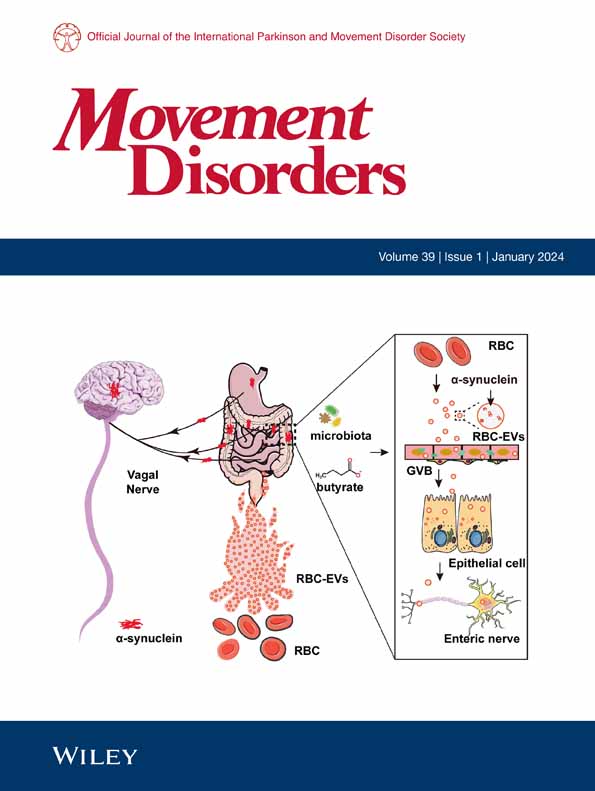早发性帕金森病和PRKN突变在马来西亚沙巴土著患者中的高频率
IF 7.6
1区 医学
Q1 CLINICAL NEUROLOGY
引用次数: 0
摘要
早发性帕金森病(EOPD)影响约10%至20%的PD患者,其中PRKN突变是最常见的原因。东南亚人,特别是土著人群对EOPD的遗传研究有限。目的研究马来西亚沙巴州土著人群EOPD和PRKN突变的频率和临床表型,并通过断点作图进一步表征该队列中高频PRKN外显子3缺失。方法:我们招募了284名土著萨巴汉人(184名PD患者,包括157名先证者和100名对照组)。对患者进行临床表型分析,并使用多重连接依赖性探针扩增、聚合酶链反应和Sanger测序进行PRKN突变筛选和断点定位。结果43.9% (n = 69/157)的先证患者有EOPD。其中56.5% (n = 39/69)携带双等位PRKN突变,纯合外显子3缺失占突变的三分之二。值得注意的是,所有PRKN-PD患者至少携带一个外显子3缺失。独孙族患者PRKN双等位基因突变频率最高(61.8%)。在所有的携带者中都发现了两个独特的PRKN外显子3缺失断点,这表明可能存在奠基者效应。在PRKN-PD患者中,纯合子外显子3缺失者的发病年龄较早(35.8±10.2比40.1±9.9),在控制年龄和病程后,残疾程度较差。结论我们发现沙巴汉土著人群中EOPD和PRKN突变的患病率非常高,为全球土著人群PD遗传学文献的匮乏提供了新的数据,并突出了EOPD高风险人群的发现,这可能是由于奠基人效应和血缘关系的结合。©2025国际帕金森和运动障碍学会。本文章由计算机程序翻译,如有差异,请以英文原文为准。
Very High Frequency of Early-Onset Parkinson's Disease and PRKN Mutations among Indigenous Patients in Sabah, Malaysia.
BACKGROUND
Early-onset Parkinson's disease (EOPD) affects approximately 10% to 20% of PD patients, with PRKN mutations being the commonest cause. Genetic studies on EOPD in Southeast Asians, especially indigenous populations, are limited.
OBJECTIVES
To investigate the frequency and clinical phenotypes of EOPD and PRKN mutations in indigenous populations from Sabah state, Malaysia, and to further characterize the high-frequency PRKN exon 3 deletion in this cohort via breakpoint mapping.
METHODS
We recruited 284 indigenous Sabahans (184 PD patients, comprising 157 probands and 100 controls). Patients were clinically phenotyped, and PRKN mutational screening and breakpoint mapping performed using multiplex ligation-dependent probe amplification, polymerase chain reaction, and Sanger sequencing.
RESULTS
Notably, 43.9% (n = 69/157) of probands had EOPD. Among them, 56.5% (n = 39/69) carried biallelic PRKN mutations, with homozygous exon 3 deletion accounting for two-thirds of the mutations. Remarkably, all PRKN-PD patients carried at least one exon 3 deletion. Patients of the Dusun tribe had the highest frequency of biallelic PRKN mutations (61.8%). Two unique PRKN exon 3 deletion breakpoints were identified in all carriers, suggesting a possible founder effect. Among PRKN-PD patients, those with homozygous exon 3 deletions had a non-significant earlier age of onset (35.8 ± 10.2 vs. 40.1 ± 9.9) and worse disability after controlling for age and disease duration.
CONCLUSION
We found a strikingly high prevalence of EOPD and PRKN mutations in indigenous Sabahans, contributing novel data to the very scarce PD genetics literature on global indigenous populations, and highlighting the discovery of populations at high risk of EOPD possibly due to a combination of founder effect and consanguinity. © 2025 International Parkinson and Movement Disorder Society.
求助全文
通过发布文献求助,成功后即可免费获取论文全文。
去求助
来源期刊

Movement Disorders
医学-临床神经学
CiteScore
13.30
自引率
8.10%
发文量
371
审稿时长
12 months
期刊介绍:
Movement Disorders publishes a variety of content types including Reviews, Viewpoints, Full Length Articles, Historical Reports, Brief Reports, and Letters. The journal considers original manuscripts on topics related to the diagnosis, therapeutics, pharmacology, biochemistry, physiology, etiology, genetics, and epidemiology of movement disorders. Appropriate topics include Parkinsonism, Chorea, Tremors, Dystonia, Myoclonus, Tics, Tardive Dyskinesia, Spasticity, and Ataxia.
 求助内容:
求助内容: 应助结果提醒方式:
应助结果提醒方式:


